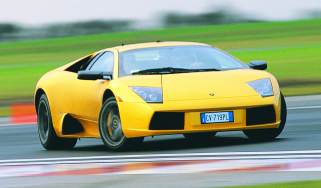Lambo's new SV: Lamborghini Murcielago SV
Final Murcielago sheds 100kg, gains 30bhp and promises 212mph, but four-wheel drive stays
How does the idea of a stripped-down, lightweight Lamborghini Murciélago LP640 with the thick end of 700bhp and rear-wheel drive grab you? Not too intimately, we hope, because the SV version of the Murciélago, the car Lamborghini will launch at the Geneva show as the farewell evolution of its flagship model and widely rumoured to answer to the above description, isn’t quite the wild, unreconstructed street fighter some were expecting.
SV (short for super veloce, or super fast) is the suffix Lamborghini has always reserved for its swansong ‘gloves off’ models. The fabled nomenclature is used sparingly but was last seen on the Murciélago’s predecessor, the Diablo, and first applied to what many regard today as the most desirable and collectable Lambo of all, the Miura SV.
The possibilities posed by 350 last-hurrah Murciélagos certainly quicken the blood, especially given the imperative to eclipse the 641bhp Murciélago-based and much rarer still Reventón as a pure driving machine. But what exactly has Lamborghini done to create its latest SV?
A diet was the obvious starting point. Lamborghini knows a bit about weight paring, of course, having successfully jettisoned 100kg from the Gallardo to create the Superleggera. But the means by which it went about it should give a few pointers to the way the SV has ended up. The all-wheel-drive Gallardo’s weight could have been cut by 50kg at a stroke by making it rear-wheel drive, and it was something Gallardo customers with hardcore leanings, as well as certain sections of the media, had been urging Lamborghini to do. But it chose, instead, to retain the four-wheel drive (quattro-loving Audi owns the Italian company after all) and pinch the savings with a more cumulative approach.
And it’s the same story with the car you see here. As its full name suggests, the Murciélago LP670-4 SV still has the four-wheel-drive system of the car it is derived from. Lamborghini says its decision to stick with this set-up, which, via its viscous coupling, can send up to 35 per cent of the driving force to the front wheels, was made purely on dynamic grounds, in particular for the superior traction afforded when accelerating out of tight bends but also for the benefit of stability overall.
Looking to the rest of the car, simply using the Superleggera as a template for the Murciélago SV was never a realistic option. For starters, unlike the aluminium monocoque Gallardo, the Murciélago has a welded-tube steel chassis. And most of the body panels that clothe it are already carbonfibre, save for the doors and doorskins, which are aluminium.
That said, the weight-loss regime targets the same four areas: the core structure, the interior, the exterior and the mechanicals. From the inside out, then, the tubular chassis is unchanged in design but is now made from a super-high-strength sectional steel that has the twin benefits of increasing torsional stiffness by 12 per cent, to the benefit of handling, and subtracting 20kg from the total vehicle weight. A useful start.
The march of carbon through the structure is uncompromising. Starting with the transmission tunnel and floor, it extends to the inner doorskins and the shells of the new bucket seats that have been specially designed for the SV. The front and rear bumpers, the rear flank panels and the casing for the third brake light are also made of a modified carbonfibre material, which, combined with the removal of the drive mechanicals for the retractable spoiler (which is replaced by a choice of two fixed spoilers), puts another 13kg in the minus column.
Further savings are made by ditching the Kenwood multi-media system, using black Alcantara microfibre (which is lighter than leather) as the dominant interior trim material, fitting lighter forged and machined alloy rims (wearing Pirelli P Zero Corsa rubber, 245/35 ZR18 at the front, 335/30 ZR18 at the rear) and replacing aluminium structural components and brackets with magnesium ones. All in all, Lamborghini’s engineers have removed 100kg of weight – 33kg from the chassis and exterior, 34kg from the interior and 33kg from the engine and drivetrain.
The latter is largely down to the completely new exhaust system, which has been redesigned and manufactured from lighter materials and, according to Lamborghini, makes 8000 revs sound like Lucifer’s hi-fi.
As well as losing kilos, the engine has, of course, also gained power. The mid-mounted 6.5-litre V12’s output – which, incidentally, has been growing year-on-year since the legendary Bizzarrini design powered its first Lambo in the 1960s – now stands at a barely credible 661bhp (670PS), 30bhp more than in the LP640. The extra power comes from modifications to the intake system and increased travel for the variably timed valves. Another weight-saving ploy is the standard fitment of the e-gear paddle-shift transmission, which requires slightly leaner hardware than the six-speed manual gearbox that will be offered as an option.
Shift times have tumbled to a new record low for e-gear but, with either transmission, Lamborghini claims a top speed of 212mph (with the smaller of the fixed rear wings) and a 0-62mph time of 3.2sec, the latter hardly seeming like an exaggeration for a car with a power-to-weight ratio of 429bhp/ton.
Keeping it all in check are lightweight carbon-ceramic brakes, which are cooled from enlarged channels in the bodyshell, while larger vents in the front bumper provide additional ventilation. The redesigned front end, made more distinctive still by being painted matt black, features a carbonfibre spoiler connected to the nose by two vertical struts. The SV’s sills are also painted matt black, along with the air vent for the oil cooler on the left-hand side of the car.
As part of the dramatic ‘open framework’ architecture of the rear end, the V12 engine is showcased under a transparent engine cover while exhaust gases exit via a single large tailpipe sitting just above the two-level carbon diffuser. The ‘Y-design’ rear lights continue the theme established by the LP640, while there’s a new carbonfibre panel between the light units and the mesh grille below now spans the full width of the rear. The larger ‘Aeropack Wing’ increases downforce at speed but reduces the SV’s top speed to 209mph.
Speaking about the new car, Lamborghini boss Stephan Winkelmann said, ‘The Murciélago SV is the systematic continuation of our brand philosophy. It is more extreme and uncompromising than virtually any other automobile. Customers can look forward to an utterly unparalleled driving experience.’
The first SVs will appear in early summer. The price is £221,335, about 20 per cent more than the LP640. It may not be quite the hard nut we were rooting for, but our mouths have gone a little dry nonetheless.
See Lamborghini Murcielago SV launch video at Geneva.




